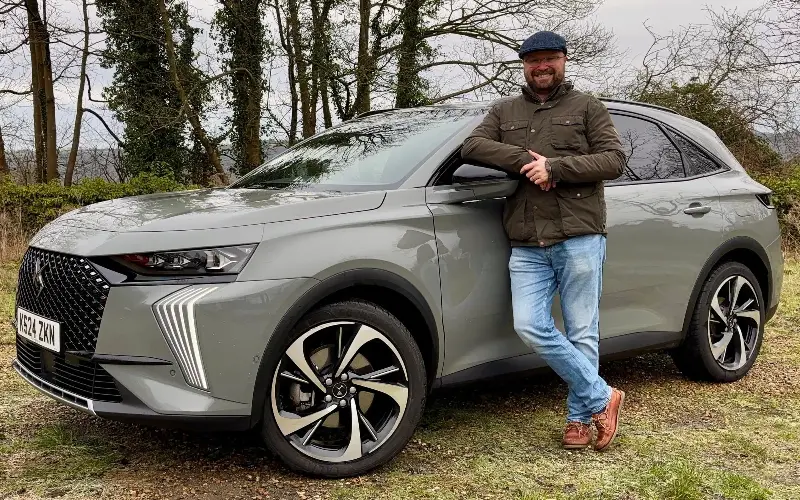
It seemed like a great idea at the time. To go with my classic Citroën DS, why not try living with a modern DS, to see what common threads between the two – if any, given the modern version’s relationship with the original could be viewed as somewhat tenuous – I could find?
The trouble is, Audrey, my DS (Okay, to purists, it’s not a fully-fledged DS, but rather a D Spécial) had other ideas. When the plan was made, she was due to emerge from a lengthy (and costly) period of repair and renovation. She did – for about a month – but then she broke again. So back into the garage she’s gone. Which is why the picture above, intended to show the two cars together… well, doesn’t.
So instead, it’s a rather more lonesome welcome for the DS 7 (no longer called Crossback, by the way, since a recent facelift). Our test car is a top-flight Opera, in plug-in hybrid form, with a potent combination of a 1.6-litre petrol turbo engine and two electric motors, capable of producing a not-inconsiderable 292bhp.
As you’d expect from a marque with ambitions of being a serious player in the premium market, the standard specification is lavish – although not quite as fulsome as you might expect. There is a panoramic roof, electrically adjustable and heated massage front seats and “watch-strap” leather upholstery.
However the lack of a wireless phone charger shows the DS 7’s age; there’s no adaptive cruise control, either.
I wouldn’t have gone for the blacked-out chrome and matt-grey paintwork myself. It’s a little bit nouveau riche for my tastes, while it also looks rather mournful on a dull day.
Lux interior
Inside, however, it’s plush. There’s a lot of quilted, diamond-stitched leather, not only on the seats but on the dashboard and the door trims. The BRM timepiece, which revolves out of the dashboard when you press the ignition, is chintzy, but does feel special (although its noisy motor takes the shine off the effect).
The usual complaints about DS’s over-heavy use of cheap-feeling switchgear from fellow Stellantis brands Peugeot and Citroën remain, however; the indicator stalks clack and the start-stop button feels plasticky. Then there are the door handles, which are made from silver metal-effect plastic, which really shows because their bezels are real metal. Not what you’d expect in a car costing almost £60,000.
A couple of other niggles are immediately obvious, too; firstly, in the boot, where there’s nowhere to store the plug-in cables, so DS issues them in a bag which takes up space. You can use Velcro to secure this to the floor – unless, of course, you’ve installed a dog-friendly boot liner to protect the carpet, in which case the bag slides around, much to the dog’s chagrin.
After some experimentation, I’ve managed to get the Velcro to grip the boot’s carpeted side panels, keeping the cables out of the pooch’s way, but this feels a bit Heath-Robinson. Annoyingly, there is an elasticated strap to secure items – but it’s not large enough to hold the bag.
Then there’s the infotainment screen. The software it uses is a re-skin of Peugeot’s but it’s a system of which we aren’t big fans. The main problems are the complicated menu structure and the laggy response, mainly caused by the juddering animations the system has been forced to produce as you switch screens and select options. It lacks the slickness of the systems you’d find in a genuinely premium rival.
Much to like
If it sounds like I’m down on the DS already, that’s not entirely true. There are lots of things I like. The design, for one thing. There are some lovely details, too – just look at the diamond-like rear lights, or the daytime running lights at the front, which splay out over the bumpers before reconvening at the corner of the headlight.
I also like the way the back seat area has been designed. This might sound odd, but when you spend large parts of your life buckling children into safety seats, it means a lot when you find a car that makes this operation easy. The DS’s doors open wide, their apertures are large and the sizeable footwells and flat floor mean you can step one leg into the car easily, allowing you to position yourself in front of the seat rather than having to stoop over from the side.
That’s about the only thing I’ve found so far that can link it to my old DS. That, and the fact the new DS has ingenious suspension aimed at maximising comfort.
The old car’s hydropneumatic suspension was known for making some passengers queasy, so I’ll be putting this car’s commitment to comfort to the test over the coming miles for an update on whether it’s a worthy successor to the famed classic.
The facts
On test: Citroën DS 7 Opera 1.6 E-Tense 300 4x4
Body style: five-door SUV
On sale: now
How much? £57,020 on the road (as tested £59,845; range from £38,810)
How fast? 140mph, 0-62mph in 5.9sec
How economical? 223mpg (WLTP Combined)
Engine & gearbox: 1,598cc four-cylinder petrol engine, eight-speed automatic gearbox, four-wheel drive
Electric powertrain: 2x AC permanent magnet synchronous motor with 14.2kWh battery, 7.4kW on-board charger, Type 2 charging socket
Electric-only range: 42 miles (WLTP Combined)
Maximum power/torque: 292bhp/383lb ft
CO2 emissions: 29g/km (WLTP Combined)
VED: £0 first year, £590 next five years, then £180
Warranty: 3 years / 60,000 miles (no mileage limit in first two years)
Spare wheel as standard: no (not available)
